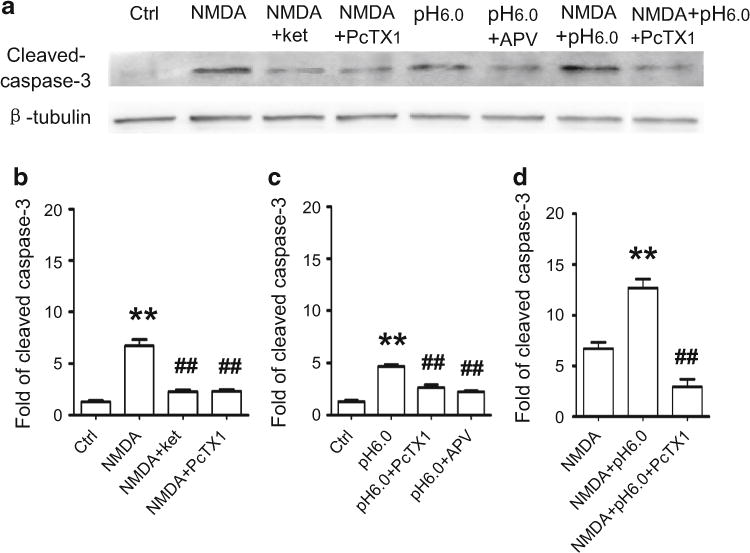Fig. 6.

NMDA-induced cleaved caspase-3 increase is enhanced by acidic ECS. a Antibody specifically recognizing cleaved caspase-3 (activated caspase-3, ~7 kD) was used to probe the activated form of caspase-3. β-tubulin served as a loading control for various treatments. The protein bands show that NMDA treatment of hippocampal cultures induced a dramatic increase in cleaved caspase-3 production. Ketamine (30 μM) suppressed the NMDA-induced cleaved caspase-3 production, and PcTX1 (50 nM) also markedly suppressed cleaved caspase-3 production. Acidic ECS (pH 6.0) treatment also induced cleaved caspase-3 production. This increase was inhibited by NMDAR antagonist APV (100 μM). NMDA plus pH 6.0 treatment of the cultures induced a dramatic increase in cleaved caspase-3, and the increase was significantly reduced by antagonizing ASIC1a. b–d Quantitative analysis of the protein band density is shown in these histograms. b NMDA treatment of hippocampal neuronal cultures induced a dramatic 6.7-fold increase (n = 4) in cleaved caspase-3 compared to control (**p < 0.01). Blocking NMDARs with ketamine or PcTX1 distinctly reduced cleaved caspase-3 production to 2.29-fold (n = 4) and 2.32-fold (n = 4) that of the control. Either ketamine or PcTX1 significantly reduced the NMDA-induced cleaved caspase-3 production. ##p < 0.01. c pH 6.0 treatment of cultures increased the cleaved caspase-3 level to 4.7-fold that of the control (**p < 0.01). This large increase was lowered to twofold (n = 4) and 1.72-fold (n = 4) that of control, respectively, by either PcTX1 or APV. ##p < 0.01 compared with pH 6.0 ECS treatment. d NMDA plus pH 6.0 treatment of cultures induced a dramatic increase in cleaved caspase-3 level to 12.7-fold (n = 4) that of the control. This increase was distinctly higher than that of NMDA treatment alone (**p < 0.01). However, pre-treatment with PcTX1 effectively lowered this increase to only 2.93-fold of control (n = 4) (##p < 0.01)
